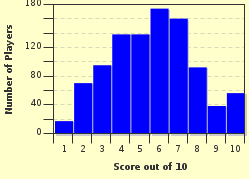Quiz Answer Key and Fun Facts
1. Chemistry encompasses the very smallest things found in science...smaller than even the microscopic protozoa found under in the most benign water (but that's another story!). Which of the following is NOT a branch of chemistry?
2. The most basic concept in chemistry is the atom -- the fundamental unit of matter. But even atoms can be broken down into smaller particles. Which of the following is NOT one of them?
3. The periodic table of elements is to chemistry as a dictionary is to English: an encyclopedic chart of everything. The periodic table is an absolute must for any chemist, for simple memorization of every single element, along with its atomic weight and oxidation number, is nigh-impossible. Try this normally simple tidbit of elemental data: Which of the following is not an element?
4. Radioactivity is a core concept in nuclear chemistry; some unstable elements, especially heavy ones, tend to "decay" and release particles, while the original atom changes into a different element. Answer me this: if a radioactive atom of carbon-14 emits an alpha particle, what atom will it become?
5. You are given three radioactive cookies. You must eat one, put one in your pocket, and hold one in your hand. However, you, being smart, are able to identify them as alpha, beta, and gamma emitters. What should you do to cause the least amount of damage to your body?
6. Enter organic chemistry, the study of all things natural and the base on which biology is founded. This deceptively simple study is based on molecules which all contain one element. Which one?
7. Generally, hydrocarbons can be classified into three groups: alkanes, alkenes, and alkynes, depending on the kinds of carbon bonds in the molecules. In these groups, molecules are individualized based on how many carbon atoms they contain. For example, pentane contains five carbon atoms, and hexane six. But for numbers of carbon atoms from one to four, hydrocarbons don't use standard scientific prefixes like mono- and di-. What are the first four hydrocarbon prefixes in order?
8. Any weight watchers out there will be familiar with the terms "saturated fats," and "unsaturated fats". These generalized names help us categorize fats into our "good" fats and "bad" fats groups. But what's the difference between the two kinds of fats?
9. On the same topic as the last question, this question deals again with fats. A majority of us have heard about the omnipresent "trans fats" in our popcorn, our burgers, our fries. But few know about the counterpart to trans fats -- ordinary fats that pose no threat whatsoever to our body. What are they?
10. A simple question for the finish: water is known as "the universal solvent" because it can dissolve many different substances. But what unique property of water makes it such a great solvent?
Source: Author
paradigmx
This quiz was reviewed by FunTrivia editor
crisw before going online.
Any errors found in FunTrivia content are routinely corrected through our feedback system.

